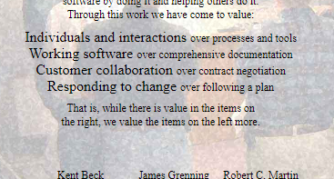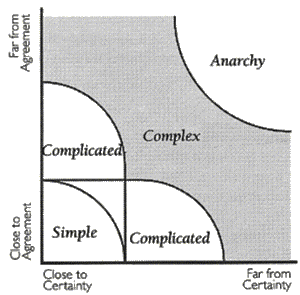Agile Training – Starting the Agile Journey

Starting the Agile Journey
Recently I have had the opportunity to present to students taking Project Management certificates and diploma courses with one of the University programs in Dublin. I was asked to do one day on agile out of the 10 or 12-day programme. These are all experienced employees spending considerable time and money on this course.
Each student has a copy of the thick brown PMP (Project Management Professional) manual which I now see has changed from white pages to grey – how apt. At the beginning of the class, I get the opportunity to ask them if they have enjoyed reading it. Was it interesting etc.?
It generally doesn’t take long for someone to say that it is impossible to read or does a project manager use this stuff? Scepticism of these methods kick-off my class nicely and it doesn’t take long for students to agree that’s it’s “a pile of …”.
Ok, I have to roll-back a little as they have spent thousands on this and I better not blow the other 90% of the course out the window yet. And I’m just making the point about the complexity of the approach suggested in the PMP.
Twelve Principles of Agile Software Development
After a short discussion on their agile knowledge, I head towards the agile manifesto and more importantly the Twelve Principles of Agile Software Development. Two areas cause particular concern:
Welcoming change even late in the day
Business people and users working together on a daily basis.

They were all concerned about changes going on forever and welcoming more changes then becoming a never-ending story. We had a good debate and on this topic, I was able to get them to agree that a dynamic business would welcome changes and a more conservative business might be better to resist them. The question “which type of business would you rather work for ?” became redundant.
I had to take the idea of Business people distracting developers every day on the chin. I couldn’t win this one, but again we did agree that it was vital to have close co-operation especially in a dynamic environment.

Onto a winner now with personas and user stories. By now I’ve started to win them over, and it was time to introduce Kanban. After the session, they all agreed to implement a personal Kanban board for their exam practice. At this stage I figure I can do no wrong, we decide to break.
The afternoon we looked at Scrum and in particular the Scrum Principles. We hit on the role of the scrum master and servant leadership. We used games to outline “work in progress”, commitment and waste. The group started to explore how agile would fit into their working environment.
Some questions arose like:
But what happens when we don’t have full-time teams?
Most of our project are about the integration of suppliers and customers?
What about change management?
How does agile fit with long-term planning?
By days end we saw some super agile concepts, and there was no disagreement that we should concentrate on getting things done as opposed to over planning everything. Agile is very important for team productivity, but scaling was still going to create a management overhead. Some attendees felt that Agile training wasn’t entirely focussed on project management but instead team management.
Brush up on your knowledge with our expert PMP evening workshop session. PMP may still have a long life but let’s stretch ourselves and be more agile.






